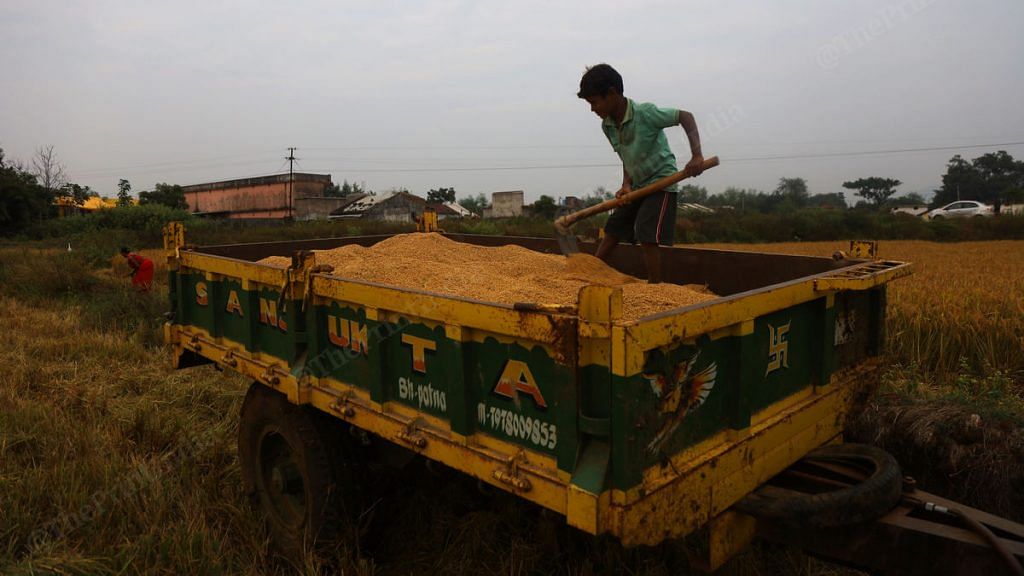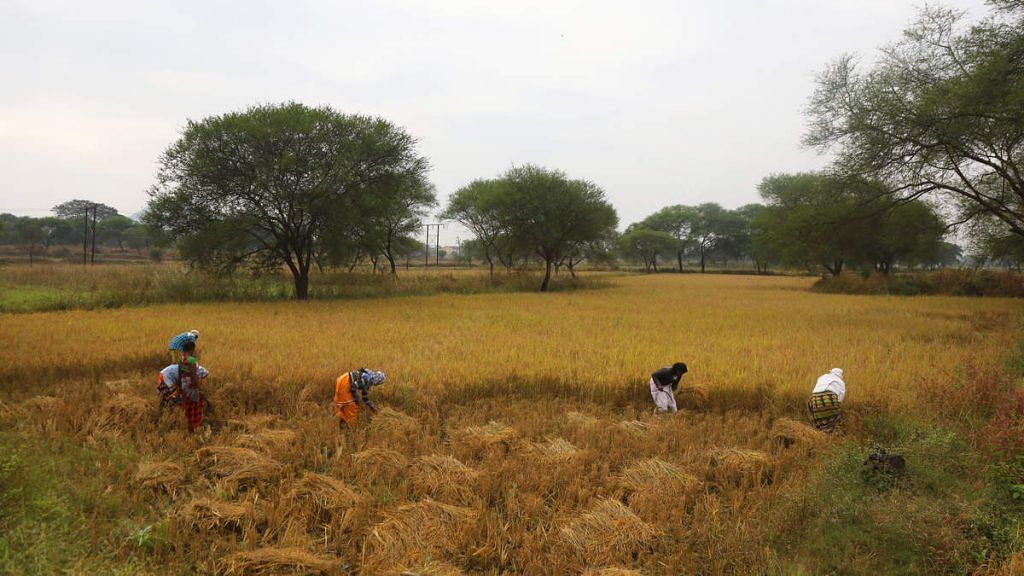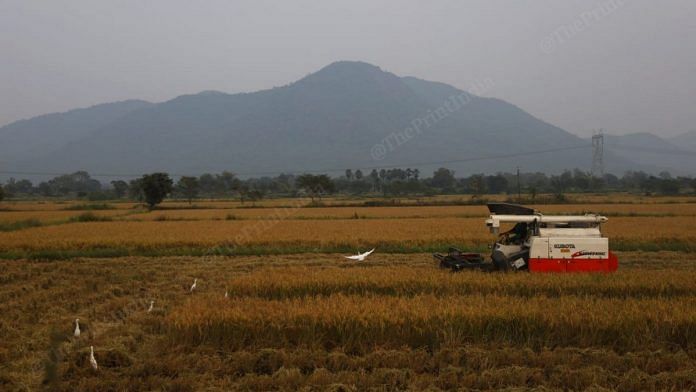Kalahandi: Ram Nath Bagh still looks a little disbelieving when he surveys his flourishing two-hectare field, located on the outskirts of Bhawanipatna, the main town of Odisha’s Kalahandi district. The 39-year-old farmer says 15 to 20 years ago, he could cultivate just enough rice for subsistence, but his yield has doubled in recent years.
“Currently we produce at least 19-20 quintals of rice… This is double the amount I used to harvest two decades back. Earlier, we just about managed to get by, but now we even register a profit at times,” a beaming Bagh tells ThePrint, crediting this improvement to better irrigation from the nearby Indravati Dam as well as higher quality fertilisers.
It’s harvest time, and adjacent to Bagh’s land is another big paddy field where a thresher is hard at work. A decade or so ago, such a sight would have been nearly impossible in this region.
Odisha’s Kalahandi-Balangir-Koraput (KBK) corridor — which encompasses the eight districts of Koraput, Malkangiri, Nabarangpur, Rayagada, Balangir, Sonepur, Kalahandi, and Nuapada — was once known as one of India’s most backward tracts. The largely rural and tribal-dominated region saw deaths due to starvation and malnourishment and large sections of the population lived in extreme poverty.
However, the KBK corridor’s fortunes have been changing, and a 2020 report of the state government noted that the region recorded a food surplus. Kalahandi is now the second-largest producer of rice in Odisha, while Balangir is the largest grower of cotton.
Somesh Upadhyay, project director of Kalahandi’s District Rural Development Agency, tells ThePrint that “starvation deaths and abject poverty are things of the past” and that the district is now known for its agricultural bounty.
However, while there are clear improvements in the region due to better irrigation and farmer-centric policies, it is evident on the ground that not every district has benefited uniformly.
Also Read: No income bar, free OPD — why Odisha says its health insurance scheme trumps Ayushman Bharat
Big strides
A 2005 report of the Planning Commission (which has since been replaced by the NITI Aayog) attributed the backwardness of the KBK region to three main factors — a hilly terrain prone to droughts and floods; a low literacy rate and extreme poverty in tribal communities; and a poor health profile due to under-nutrition, endemic malaria, and other localised diseases.
However, this dire situation has turned around quite dramatically. A 2020 report, produced jointly by the state government’s Planning and Convergence Department and the United Nations World Food Programme, went as far as to say that “Bargarh, Ganjam and Kalahandi are the food grains bowl of the state”.
According to Upadhyay, irrigation projects from the Indravati Dam, which was completed in 1996, have been the “game-changer”, along with upliftment efforts like the Biju KBK Yojana, a state government scheme named after former CM Biju Patnaik, the late father of current CM Naveen Patnaik, that provides extra funds to develop the region.
Kalahandi District Magistrate Gavali Parag Harshad explains that although the Indravati Dam was built in the 1990s, it took nearly two decades to properly irrigate the nearby fields. In January this year, the state government also officially launched the Upper Indravati Lift Canal, which essentially channels water up to the Kalahandi highlands.

Harshad adds that the administration is also encouraging farmers to turn to pisciculture (fish farming) and cash crops like bananas since paddy cultivation is water-intensive and costly. “The more people who move out of paddy, the better it is. Paddy procurement is a big problem too. Our main focus is to ensure a stable livelihood for farmers,” Harshad says.
In Balangir district, which neighbours Kalahandi, District Magistrate Chanchal Rana says a “major transformation” has taken place after identifying and addressing “migration-prone” blocks. Rana says under the Mahatma Gandhi National Rural Employment Guarantee Act (MGNREGA), such blocks in Balangir as well as Nuapada districts provide 300 days of guaranteed employment to counter distress migration. MGNREGA usually covers wages for 100 days of employment, but the state government covers costs for 200 additional days.
Another promising scheme, according to Rana, is ‘Mission Shakti’ under the Odisha Livelihood Mission, which encourages women to form self-help groups focusing on livelihood.
Rana also says the district is now developing its own irrigation projects. “We will develop the Lower Indra Project, which will irrigate close to 50,000-55,000 hectares of land. In addition, we are also looking at avenues for flood irrigation in areas where there are less water-efficient crops,” he says.
“We have also rolled out our cluster borewell project. In this, five farmers can get together and purchase a borewell, which we will give at subsidised prices. We are also looking at farm ponds for areas where irrigation is not possible,” Rana says, adding that the farm ponds will also be equipped with solar water pumps. However, he acknowledges that many farmers still live under bleak conditions.
Also Read: Matilda Kullu — Odisha ASHA worker on Forbes list who battled Covid, superstition & casteism
Uneven improvements
Just 50 km from Bhawanipatna, on the outskirts of Kalahandi and bordering Balangir district, is Kessinga village. Here, the paddy fields are not as rich, and farmers usually produce just about enough to feed themselves.
Momona Banwali Thandi, a farmer in Balangir’s Luchkibahal village, who owns land with his son, laments that this season’s paddy crop is kharab (spoilt) due to lack of rainfall, as he examines a fistful of the crop he just cut. “Water is the main issue. We can’t sell any of this… it is only for us to eat,” Thandi says, although he does acknowledge that food production is much better than it was a couple of decades ago.
Water is still the biggest source of worry for farmers — the general refrain is that irrigation is patchy, which means that most farmers are still dependent on rainfall. Unlike central Kalahandi, where most people are dedicated to farming alone, farmers in and around Balangir also double up as carpenters and labourers to sustain themselves.
In Kalahandi, too, there is scope for improvement. Many farmers say that though they do register a profit, these proceeds go primarily into buying fertilisers and equipment geared towards paddy cultivation.
“We want loans from the government so that we have more cash in our pockets,” Basanto Kumar Deep, a paddy farmer in Kalahandi, says.

Closing the gaps: Ragi cultivation, iron tablets part of solution
Local officials in Kalahandi and Balangir say efforts are underway to ensure a stable income for farmers and to steer them away from water-intensive paddy by encouraging them to shift to cash crops like ragi, banana, and tomato, or to explore new ventures like pisciculture.
DM Rana says ragi cultivation is a particularly promising pivot. “In the [Naxal] extremism-prone areas of the district, we have also kickstarted massive ragi cultivation as it barely requires any water and is a low maintenance crop,” Rana says, adding that dairy farmers are also being given interest-free loans.
Another problem in the region is that despite the much-touted food surplus, the nutritional indices are still below par. According to the state government report cited earlier on food security and nutrition, the KBK region (all eight districts) still sees a high rate of stunting and malnutrition. There is also a high incidence of anaemia — 67.4 per cent of the under-five population is anaemic. Most people are also consuming far less than the recommended daily allowance (RDA) of fats, protein, and energy.
The district magistrates of both Kalahandi and Balangir say they are working towards addressing the issue of nutritional deficiencies. Efforts are now on, they say, to distribute iron tablets to combat anaemia. De-worming tablets are also being distributed as parasites have been identified as one of the main reasons for poor nutrition.
(Edited by Asavari Singh)
Also Read: New corridor, more breathing space — how Puri Jagannath temple is revamping for the times



